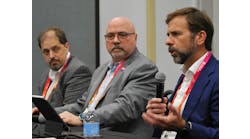Three tech trends converge at automation inflection point
“Artificial intelligence (AI) is to play an important part in the evolution of industrial technologies,” began Cyril Perducat, senior vice president and chief technology officer at Rockwell Automation during the opening keynote session of this week’s Automation Fair event in Anaheim, Calif. “And it’s the convergence of AI with integrated robotics and software-defined automation (SDA) that have created a unique inflection point for industry.”
“It’s also about how people work differently,” added Perducat. “How can we use technology to help people do a better job?”
“When I speak of these three things, there is a clear path to the future we’ve identified,” Perducat explained. “This is a reality, not just a roadmap. If we can bring integrated robots, artificial intelligence and software-defined automation together, we elevate human work, moving industrial operation to industrial autonomy. We have a lot of exciting innovations that are not a vague intention for the future, but real and practical.”
Manufacturers are looking for more people, not trying to replace the ones they already have, he added. “It’s a revolution of humans and technology working together. How do we have an impact? That is also happening at this inflection point.”
“We believe there is a future related to choices we make today about tomorrow,” Perducat continued. “The technology should not be a trap that ensnares the user; it should be chosen because it’s the right technology,” he said. Flexibility, agility and simplification should be important features.
“I want to double-down on human-centric design,” Perducat added. “When you use products, why are they great? Because they just work, and they’re simple. A self-organizing production system operates at the set design of performance. How do we create a system that optimizes itself?”
Perducat summarized Rockwell Automation’s future technology direction in these six guiding principles:
- Production systems adapt to change in real time.
- AI enables industrial autonomy.
- Interoperability allows seamless communication.
- Technology enables flexibility, agility and openness.
- AI gives people superpowers by making jobs more exciting.
- People and machines reach their highest potential by working together.
These principles applied to integrated robotics, AI and SDA will reinvent industrial automation, he said.
Integrated robotics
Autonomous mobile robots (AMRs) can be used to replace dull, dirty and dangerous tasks, explained Matt Rendall, CEO, OTTO Motors and Clearpath Robotics, who joined Perducat on the keynote stage. “By aligning your human workforce with your robotic workforce, you can improve operation and make a safer workplace,” he said.
“We’ve got state-of-the-art sensors on our OTTO autonomous mobile robots that can process the data, making it a data machine,” explained Rendall. By combining that with Rockwell Automation’s FactoryTalk DataMosaix, users can do things like determine which part of the production process can be better optimized.
“Most of industry isn’t data-connected to the cloud,” noted Rendall. The OTTO Motors AMR equipped with the Husky Observer system can take that data collection to the point where it’s needed, creating a sensor on wheels with mobile manipulation of the data. “We’re fueled by the question of what’s possible,” he said.
Artificial intelligence
One key frontier of AI applications in industry will be its inclusion in closed-loop systems, and AI and autonomy already go beyond an academic curiosity, explained Jordan Reynolds, vice president, artificial intelligence and autonomy, Rockwell Automation. “We’re incorporating AI into production systems—at the sensing layer, the control layer, at the supervisory and operations management levels,” he said. “If we could imagine these systems for the first time, knowing we could incorporate self-learning and knowing they could adapt and solve complex problems, how would we create them differently?”
One way Rockwell Automation is using AI to create value is in design. “A lot of the painstaking labor and decision-making take place in system design,” said Reynolds. “It’s a laborious process that stands in the way of production and making money.”
Industrial AI starts with the digital twin, Reynolds proposed. Rockwell Automation’s Emulate3D digital twin software simulates a production line’s geometry and physics. “If you’re designing a greenfield plant or upgrading a brownfield one, you can use a digital twin to train your AI,” explained Reynolds. “And when it comes time to write PLC code, we’ve integrated AI into our FactoryTalk Design Studio Copilot. You simply issue a natural-language prompt and objectives, and it writes the code for you.”
The code can then be validated against the digital twin before being used in a production environment. “I can emulate how that code is likely to perform using Emulate3D. This can also serve as a systemic feedback loop to improve control performance,” explained Reynolds.
Complex advancements in sensing and control capabilities can also be accomplished with machine-learning functions, said Reynolds. “At the sensing level, we’re announcing an intelligent machine vision inspection system at Automation Fair,” he said. “It’s neural-network-based. You simply provide it with examples of what good and bad look like.”
“With FactoryTalk Analytics VisionAI, we have the ability to identify defects,” Reynolds added. “And at the control level, I can train a complementary model to reject a defective product,” noted Reynolds. “Analytics LogixAI gives any ControlLogix PLC that power. There’s a symbiotic relationship between sensing and control, bringing AI into an autonomous closed-loop system.”
Predictive maintenance can be simplified, as well. Rockwell recommends starting on that journey by leveraging the capabilities already present on the manufacturing floor. “Our variable-frequency drives (VFDs) have embedded sensors,” explained Reynolds. “And FactoryTalk Analytics GuardianAI does anomaly detection on the VFD system.”
“This is a great way to start on a predictive-maintenance strategy,” said Reynolds. “You already have a drive. We can augment it with GuardianAI capabilities. It will advise you if you need to plan a predictive-maintenance procedure, and when you need to do it.”
Software-defined automation
System architecture needs to be looked at in a different way, said Dan DeYoung, Rockwell Automation’s vice president and general manager, design and control. “Past approaches are insufficient for industrial automation,” he declared. “The shift to software-defined automation (SDA) is imminent. It starts with hardware-agnostic programming. With software-defined automation, you’ll see Logix become deployable as a workload.”
Software-defined automation is more than a virtual PLC. “It can be deployed in what you know as ControlLogix, CompactLogix or other edge computing platforms,” explained DeYoung. “The applications you’ve already created will be portable to a range of hardware platforms.”








